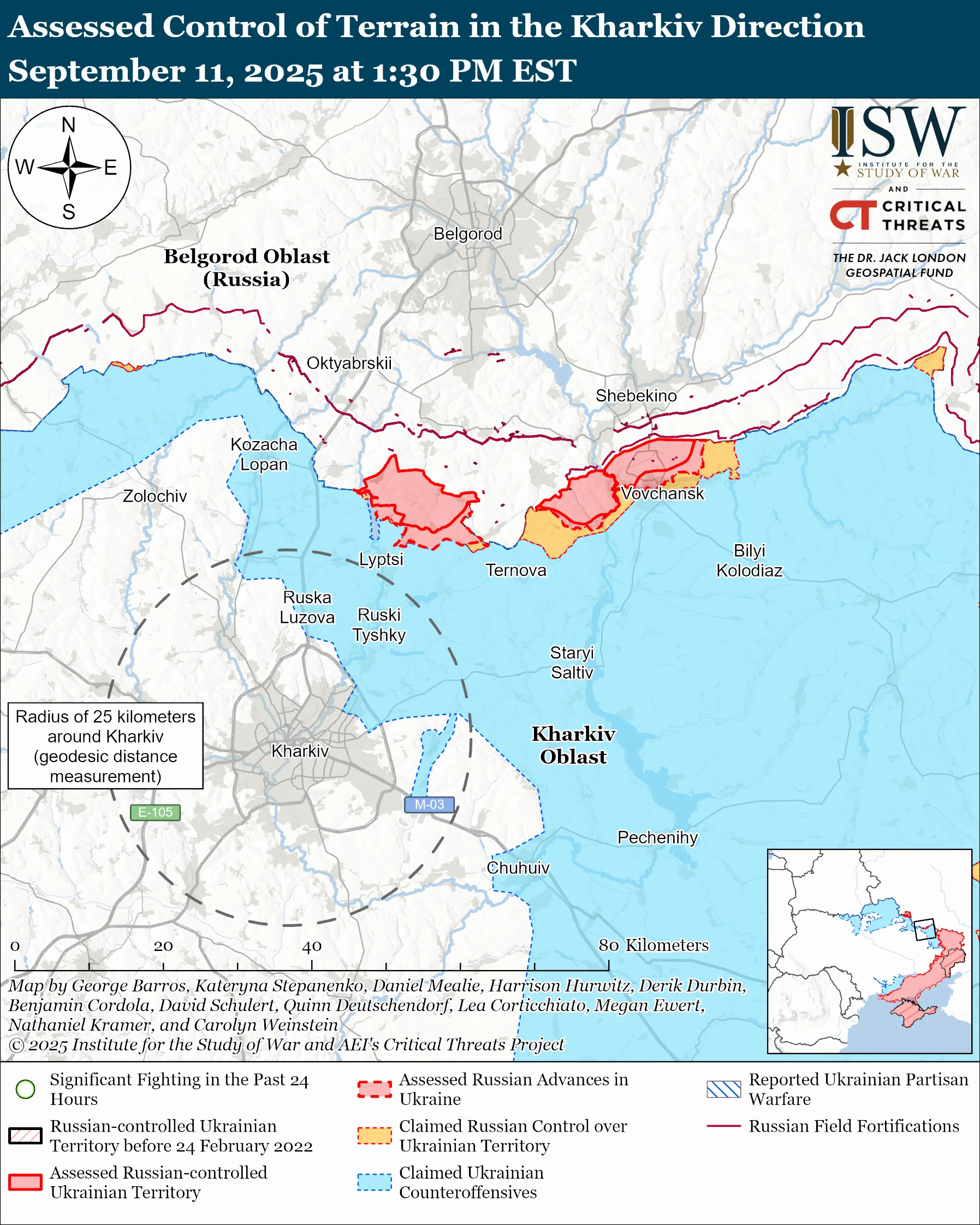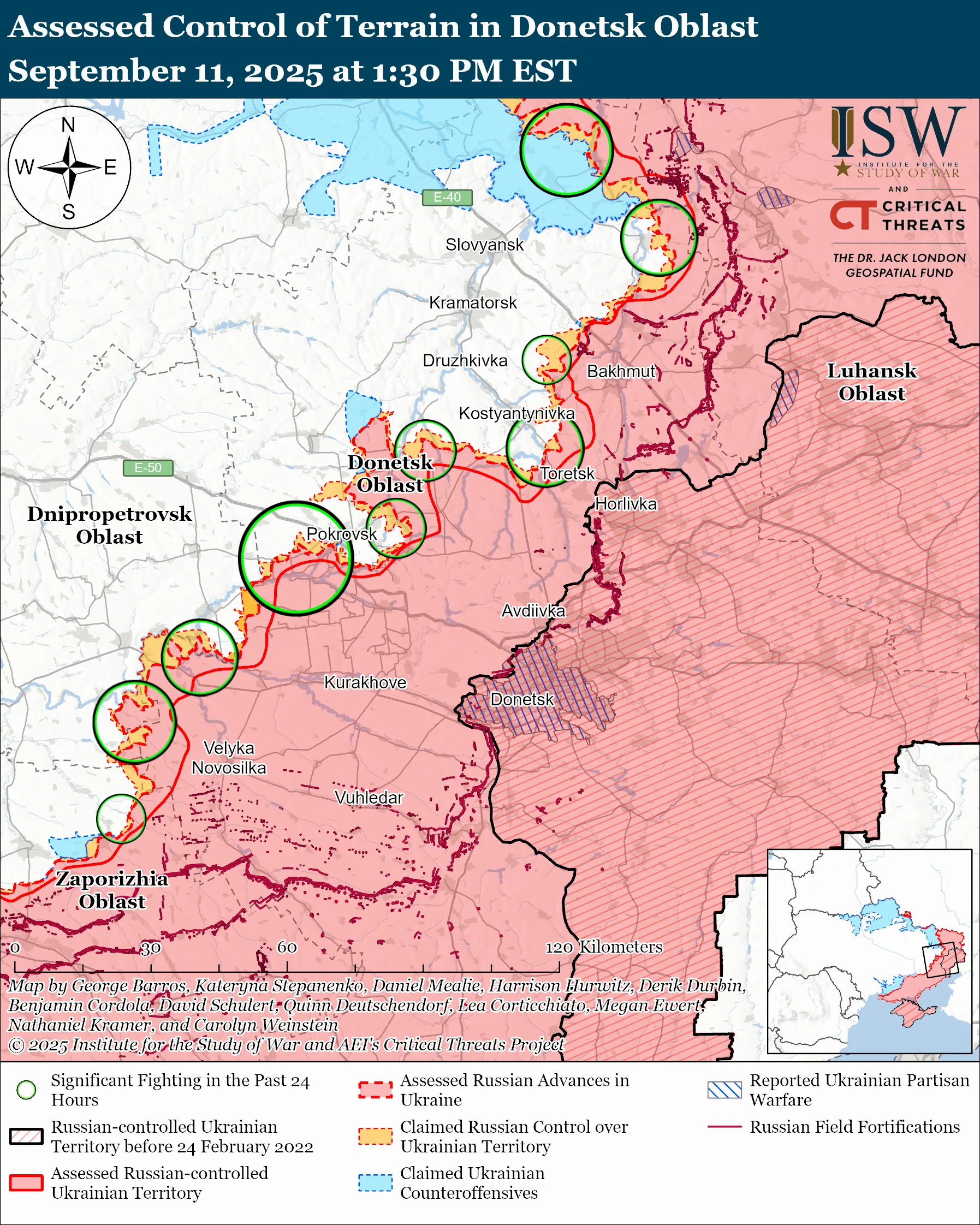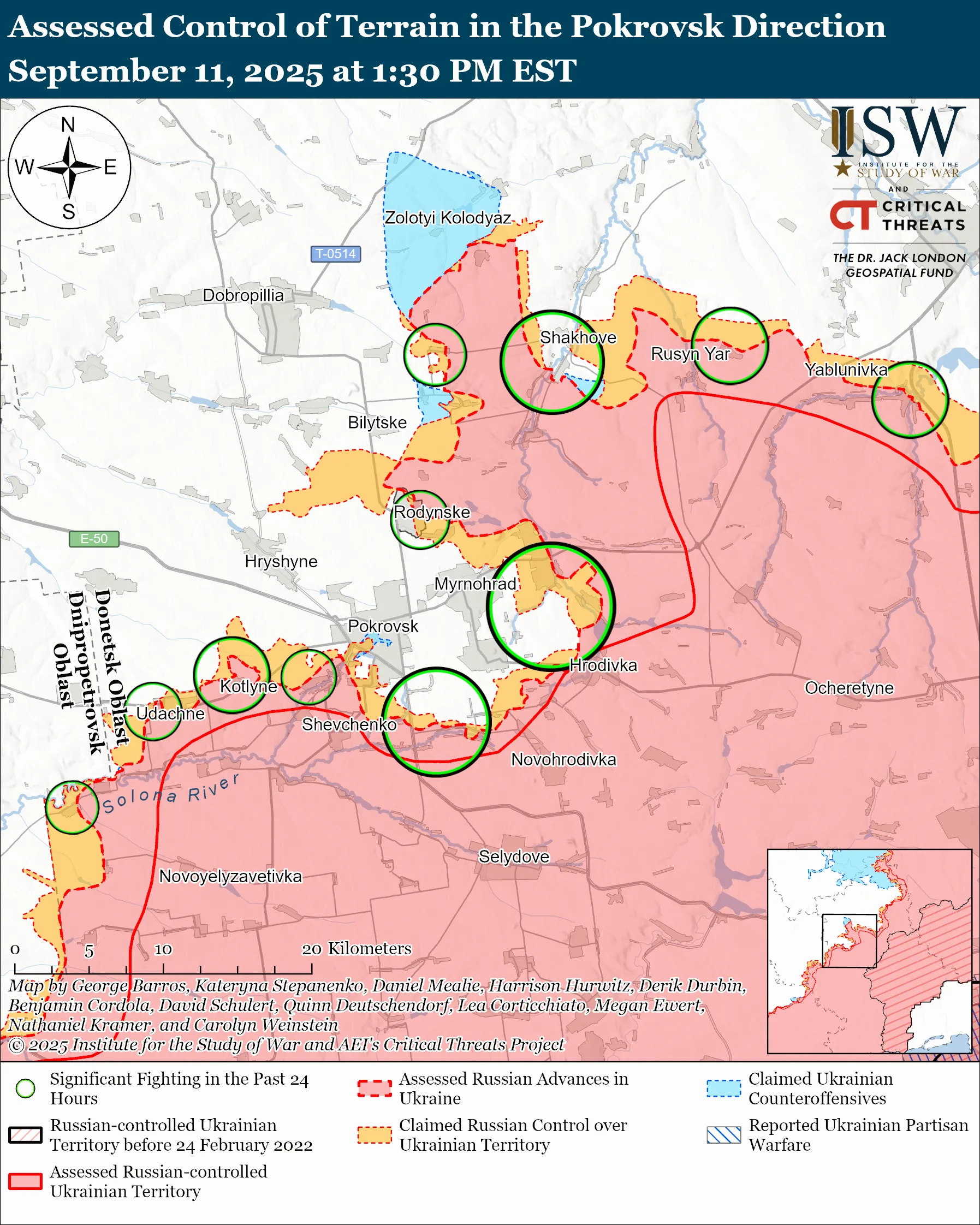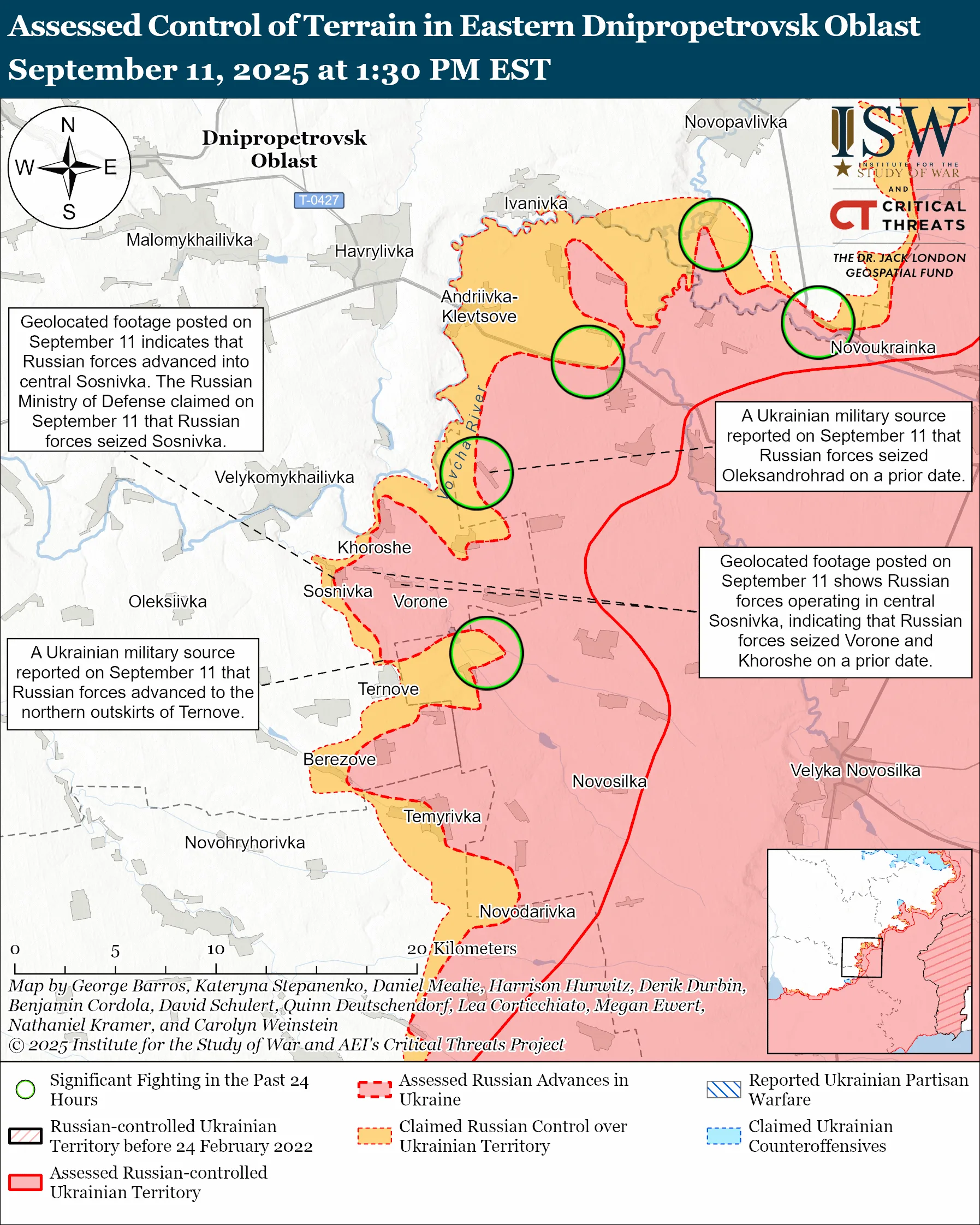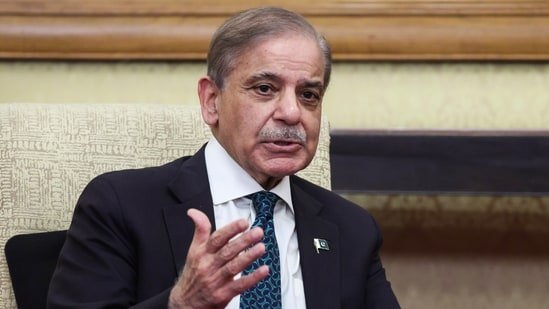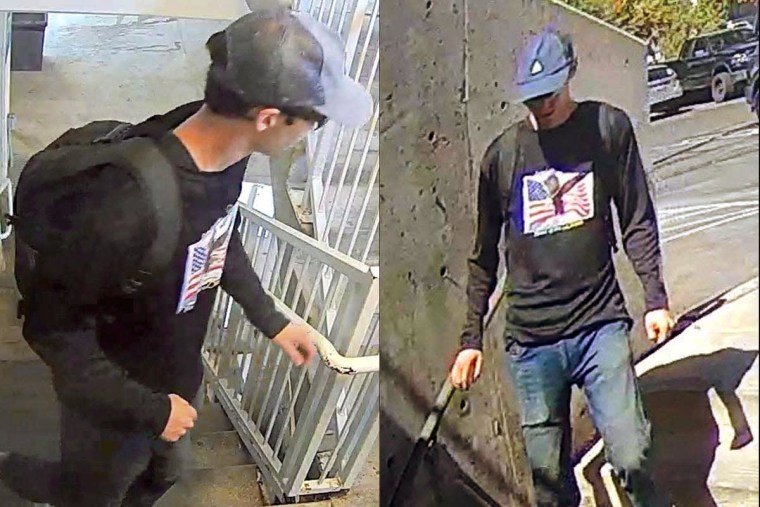Polish officials provided additional clarification on the impacts of the September 9-10 Russian drone incursion into Polish airspace. Poland’s Ministry of Internal Affairs reported that as of 1900 local time on September 11, Polish law enforcement agencies found 17 total drones throughout eastern and northern Poland.[1] Polish media reported that at least one drone crashed near a Polish Territorial Defense Force unit in Nowe Miasto nad Pilicą (southwest of Warsaw).[2] A Polish defense analyst stated that at least 15 of the recovered drones were Gerbera decoy drones, many of which were equipped with fuel tanks that doubled their range to as far as 900 kilometers.[3] The Polish Air Navigation Services Agency announced that it will limit air traffic in eastern Poland along the borders with Ukraine and Belarus until December 9 in response to the September 9-10 drone incursion.[4] Polish media reported on September 11 that about 40,000 Polish troops will deploy to the Poland-Belarus border area as a result of heightened tensions following the drone incursion and the upcoming Russia-Belarus Zapad-2025 joint military exercises, which begin on September 12.[5] Latvian Defense Minister Andris Spruds stated that Latvia will also close its airspace along its eastern border with Belarus and Russia until at least September 18, following in Poland’s footsteps.[6]
Poland’s allies reiterated their support for Poland following the drone incursion, condemning Russia for purposefully conducting the incursion to test NATO readiness. Polish Deputy Defense Minister Władysław Kosiniak-Kamysz reported on September 10 that Sweden has provided an emergency package of air defense assets and aircraft to Poland; that the Netherlands is providing Poland with systems such as Patriots, National Advanced Surface-to-Air Missile Systems (NASAMS), and anti-drone systems; and that other allies are also providing Poland with concrete declarations of support.[7] Czech Defense Minister Jana Černochová announced during a phone call with Kosiniak-Kamysz that Czechia will provide a helicopter unit with specially modified Mi-171 helicopters to Poland following the drone incursion.[8] Several NATO member states, including the Netherlands and Czechia, summoned Russian ambassadors due to the drone incursion.[9] Bloomberg reported on September 11 that a source familiar with the matter stated that NATO is preparing unspecified defensive military measures in response to the drone incursion into Poland, in addition to a political response.[10] German Chancellor Friedrich Merz stated that Russia deliberately provoked NATO during the drone incursion and noted that this was “part of a long series of provocations” along NATO’s entire eastern flank.[11] ISW assessed on September 10 that the Russian drone incursions were part of a multipronged and longstanding Russian effort to test NATO’s technical capabilities and political resolve in preparation for a potential future war with NATO.[12]
Ukrainian officials responded to the drone incursion by drawing parallels to Russian cycles of aggression and escalation against Ukraine and offered to share Ukraine’s now-institutional counter-drone knowledge with Poland. Ukrainian President Volodymyr Zelensky stated during a meeting with Finnish President Alexander Stubb on September 11 that Russia flew drones into Poland on September 9-10 in order to test NATO’s military and political abilities to respond to Russian kinetic provocations.[13] Zelensky noted that the psychological effects of the drone incursion mirror the psychological impacts of Russia’s deployment of “little green men” to Crimea before the illegal occupation of the peninsula in 2014. Zelensky implied that Russia hopes to use these drone strikes to push the Overton Window of what NATO is willing to absorb as an “acceptable” escalation, much like Russia did when it deployed unmarked, illegal combatants to Crimea to seize the peninsula in 2014. Zelensky also reaffirmed that Ukraine has offered to help train Polish forces to shoot down Russian drones.[14] Ukraine has developed invaluable tactics and technologies to effectively counter Russian drone strikes, and NATO states must work to absorb and institutionalize this experience the way Ukraine has in order to properly respond to potential Russian kinetic aggression against the alliance.
The Kremlin continues efforts to destabilize the Balkans and dismantle the 1995 Dayton Accords that ended the 1992-1995 Bosnian War, likely as part of a larger campaign to divide and distract Europe. Russian Foreign Minister Sergei Lavrov met with President of Republika Srpska (the Serbian political entity within Bosnia and Herzegovina) Milorad Dodik on September 9 in Moscow and gave a press conference following the meeting.[15] Lavrov stated that he and Dodik met on the thirtieth anniversary of the signing of the Dayton Accords, which ended NATO “aggression” in Bosnia and Herzegovina during NATO’s 1995 Operation Deliberate Force. Lavrov stated that Russia is one of the guarantors of the December 1995 Dayton Accords and accused the West of “trampl[ing]” on the accords to gain “undivided control” over Bosnia and Herzegovina and strip the Serbs of their rights. Lavrov stated that “external interference” in Bosnia and Herzegovina is inadmissible and that Russia condemns Western attempts to remove “undesirable” Serbian leaders from power, referencing the fact that the appeals court in Bosnia and Herzegovina recently sentenced Dodik for disregarding the decisions of an international peace envoy and defying the Constitutional Court.[16] Lavrov claimed that “destroying the consensus that underlies Bosnia and Herzegovina is… an invitation to another war in the Balkans.” Lavrov praised Dodik for planning a referendum in Republika Srpska in October and claimed that “the West does not like referendums,” including the “transparent” referendum in Crimea. Lavrov and Dodik notably met on the same day that Russia launched a major drone incursion in Polish airspace, which likely also sought to test NATO and EU unity.[17] The Kremlin has previously leveraged its relationship with Republika Srpska to further influence the Balkans, sow divisions in Europe, and undermine the US-backed Dayton Accords to throw the Balkans into turmoil.[18]
Russian state media is acknowledging the growing gasoline shortages in Russia, but is downplaying the role that Ukraine’s deep strike campaign is playing in generating these shortages. The Russian Independent Fuel Union, an association of gas station owners, stated in an interview with Russian state newspaper Izvestiya on September 10 that over 10 Russian federal subjects are experiencing fuel shortages, including Ryazan, Nizhny Novgorod, Saratov, and Rostov oblasts, Far Eastern regions, and occupied Crimea and that fuel shortages are also reaching central regions such as Nizhny Novgorod Oblast.[19] Russian State Duma Anti-Monopoly Committee Expert Council member Dmitry Tortev told Izvestiya that local fuel shortages are becoming widespread in Russia. Russian Independent Fuel Union representatives stated that many gas stations have not received refinery deliveries for several weeks, forcing some gas stations to shut down. Russian officials downplayed the impact of Ukraine’s strike campaign, attributing the fuel shortages to peak vacation season and agricultural demands in August and September 2025.[20] ISW continues to assess that Ukraine’s strike campaign against Ukrainian energy infrastructure is impacting Russia’s domestic gasoline market, exacerbating shortages, and causing price spikes that will likely push inflation upwards and create further macroeconomic instability in Russia.[21] It is noteworthy that Russian state media is more openly discussing gasoline shortages, as it suggests that the issue is beginning to permeate into more mainstream Russian society.
Sweden pledged additional military and financial assistance to Ukraine. The Swedish Ministry of Defense (MoD) reported on September 11 that Sweden announced its twentieth military aid package to Ukraine, which allocates roughly 9.2 billion Krona (SEK) ($987 million) for battlefield needs.[22] The Swedish MoD procured 18 Archer guns and artillery ammunition as well as long-range drones, worth roughly 3.6 billion SEK ($386 million); marine equipment, including coastal radar systems, rope ferries equipped with grenade launchers, diving chambers, and crane trucks, worth 2.1 billion SEK ($225 million); air defense (AD) equipment, including ammunition, equipment and sensors for air base operations, sensors to detect drones and robots, and sensors and control systems for the already-donated Swedish Tridon system, worth 3.5 billion SEK ($367 million); and other investments in civil defense and services via the Swedish National Defense Research Institute and the Swedish National Defense University. The Swedish MoD also announced that the Swedish government proposed adding an additional 31.5 billion SEK ($3.3 billion) to the budget bill for 2026 and an extension of support to 2027, amounting to 40 billion SEK ($4.2 billion) in 2026 and 2027, respectively.
Russian Main Effort: Eastern Ukraine
Russian Subordinate Main Effort #1
Russian objective: Push Ukrainian forces back from the international border with Belgorod Oblast and approach to within tube artillery range of Kharkiv City.
Russian forces continued offensive operations in northern Kharkiv Oblast on September 11 but did not make confirmed advances.
Unconfirmed claims: Russian sources claimed that Russian forces advanced west of Synelnykove and on the left (south) bank of the Vovcha River within Vovchansk (both northeast of Kharkiv City).[34]
Russian forces attacked northeast of Kharkiv City near Synelnykove and in western Vovchansk on September 10 and 11.[35] Russian sources claimed that Ukrainian forces counterattacked on the left bank of the Vovcha River within Vovchansk and near Synelnykove.[36]
The deputy commander of a Ukrainian corps operating in the Kharkiv direction stated on September 11 that Russian forces continue their “summer offensive” in this direction.[37] The deputy commander added that the Russian military command considers the Kharkiv direction a secondary effort to the main effort in the Pokrovsk direction, but has nevertheless concentrated roughly two combined arms armies (CAAs) in the Kharkiv direction. The deputy commander stated that Russian forces are using People’s Republic of China (PRC)-manufactured fiber optic, first-person view, and Mavic drones in the Kharkiv direction and employing infiltration tactics to gradually accumulate forces and advance in the Ukrainian near rear.
Order of Battle: Drone operators of the Russian Anvar Spetsnaz Detachment (possibly referring to the BARS-25 Anvar volunteer detachment) are reportedly striking Ukrainian forces in the border areas of Chernihiv and Kharkiv oblasts.[38]
Russian forces continued offensive operations in the Velykyi Burluk direction on September 11 but did not advance.
Russian forces attacked northeast of Velykyi Burluk near Ambarne and east of Velykyi Burluk toward Odradne on September 10 and 11.[39]
The Ukrainian Dnipro Group of Forces stated on September 10 that Russian forces in the Velykyi Burluk direction are preparing for a renewed offensive toward Ambarne.[40]
Russian Subordinate Main Effort #2
Russian objective: Capture the remainder of Luhansk Oblast and push westward into eastern Kharkhiv Oblast and encircle northern Donetsk Oblast
Russian forces continued offensive operations in the Kupyansk direction on September 11 but did not advance.
Russian forces attacked near Kupyansk itself; north of Kupyansk near Holubivka; northeast of Kupyansk near Myrove; east of Kupyansk near Petropavlivka; and southeast of Kupyansk toward Kurylivka on September 10 and 11.[41]
Ukrainian military observer Kostyantyn Mashovets reported on September 11 that Ukrainian forces have observed Russian infiltration groups of two to six personnel operating near Kupyansk, Blahodativka (west of Kupyansk), Kindrashivka, and Myrove (both northwest of Kupyansk).[42] Mashovets reported that the Russian infiltration forces use forests and urban areas for concealment, dress in civilian clothes, and move at night. Mashovets stated that the 1st Guards Tank Army (GTA, Moscow Military District [MMD]) and 6th Combined Arms Army (CAA, Leningrad Military District [LMD]) are also intensifying classic assault operations and are combining assault and infiltration tactics.
A non-commissioned officer (NCO) of a Ukrainian battalion operating in the Kupyansk direction reported that Russian forces are using a variety of first-person view (FPV) drones and Lancet loitering munitions in the Kupyansk direction.[43] The NCO noted that Russian forces have decreased their use of heavy equipment and are instead relying on motorcycles and ATVs, which are faster and harder to detect.
Order of Battle: Mashovets reported that elements of the 27th Motorized Rifle Brigade (1st GTA, MMD) are operating in the Kupyansk direction.[44]
Russian forces continued offensive operations in the Borova direction on September 11 but did not make confirmed advances.
Unconfirmed claim: A Russian milblogger claimed on Sep 11 that Russian forces advanced west of Zelenyi Hai (northeast of Borova) and north of Novoiehorivka (southeast of Borova).[45]
Russian forces attacked northeast of Borova near Borivska-Andriivka, Zelenyi Hai, and Nova Kruhlyakivka; and southeast of Borova near Hrekivka and Olhivka on September 10 and 11.[46] A Russian milblogger claimed that Ukrainian forces counterattacked southeast of Borova near Maliivka.[47]
Russian forces recently advanced in the Lyman direction.
Assessed Russian advances: Mashovets reported on September 11 that Russian forces seized Serednie (northwest of Lyman).[48]
Unconfirmed claims: Russian milbloggers claimed that Russian forces advanced northwest of Lyman to the west of Serednie and southwest of Shandryholove; north of Lyman to the northwest of Stavky and to the south of Novyi Myr; and east of Lyman to western Zarichne.[49] A Russian source claimed that Russian forces advanced to the southwest border of Zarichne.[50]
Russian forces attacked northwest of Lyman near Serednie and Shadryholove and toward Drobysheve and Derylove; north of Lyman near Novomykhailivka and Ridkodub and toward Stavky; northeast of Lyman near Kolodyazi; and east of Lyman near Torske and Zarichne on September 10 and 11.[51] A Russian milblogger claimed that Ukrainian forces are counterattacking near Novyi Myr and Zarichne.[52]
Mashovets reported that small groups of Russian forces are infiltrating and attempting to gain a foothold in Shandryholove.[53] Mashovets reported that the command of the Russian 20th CAA (Moscow Military District [MMD]) and 25th CAA (Central Military District [CMD]) shifted their focus from advancing northwest of Lyman towards the Oskil River to advancing southwest towards Lyman itself.
Order of Battle: Mashovets reported that elements of the Russian 144th Motorized Rifle Division (20th CAA, including its 488th Motorized Rifle Regiment) are reportedly operating near Kolodyazi, Serednie, and Shandryholove.[54] Mashovets reported that elements of the 164th Motorized Rifle Brigade (25th CAA), the 19th Tank Regiment and 37th Motorized Rifle Regiment (both of the 67th Motorized Rifle Division, 25th CAA, CMD), 1234th Motorized Rifle Regiment (4th Tank Division, 1st Guards Tank Army [GTA], MMD), 169th Motorized Rifle Brigade, and the 11th Tank Brigade (both 25th CAA, CMD) are operating near the Serebryanske Forest (southeast of Lyman). Drone operators of the 16th Spetsnaz Brigade (Russian General Staff’s Main Directorate [GRU]) are striking Ukrainian objects in the Lyman direction.[55] Drone operators of the 423rd Motorized Rifle Regiment (4th Tank Division, 1st GTA, MMD) are reportedly operating near Lyman.[56]
Russian Subordinate Main Effort #3
Russian objective: Capture the entirety of Donetsk Oblast, the claimed territory of Russia’s proxies in Donbas, and possibly advance into Dnipropetrovsk Oblast
Russian forces continued offensive operations in the Siversk direction on September 11 but did not make confirmed advances.
Unconfirmed claims: Russian milbloggers claimed on September 11 that Russian forces are advancing between Serebryanka and Hryhorivka (northeast of Siversk).[57] A Russian milblogger claimed that Russian forces captured an unspecified Ukrainian logistics route near Dronivka (northwest of Siversk), but did not specify if Russian forces physically control the route or established fire control over it.[58]
Russian forces continued ground attacks northeast of Siversk near Hryhorivka and Serebryanka; northwest of Siversk towards Dronivka; and southeast of Siversk towards Vyimka on September 10 and 11.[59]
A Russian milblogger claimed that Russian forces are, for the first time, using the tactic of creating “kill zones” along Ukrainian ground lines of communication (GLOCs) in the Siversk direction.[60] The ”kill zone” likely refers to an area immediately near the frontline where a mass of tactical strike and reconnaissance drones pose an elevated risk to any equipment or personnel that enters the area. [61]The milblogger claimed that Russian forces can strike Ukrainian vehicles and personnel along the M-03 Slovyansk-Izyum highway (northwest of Siversk) up to 30 kilometers from the current Russian frontline with drones.[62] The milblogger clarified that Russian forces are able to create this 30 kilometer kill zone with the use of “mothership” drones that carry up to 20 smaller drones to a specified area and then release the smaller drones, thereby expanding drone range.
Russian forces recently advanced in the Kostyantynivka-Druzhkivka tactical area.
Assessed Russian advances: Geolocated footage published on September 11 indicates that Russian forces advanced in fields north of Bila Hora (southeast of Kostyantynivka).[63] Additional geolocated footage published on September 11 shows that Russian forces advanced westward along the T0516 Toretsk-Kostyantynivka road in eastern Nelipivka (also southeast of Kostyantynivka).[64] Geolocated footage published on September 11 also shows that Russian forces advanced to a windbreak north of Yablunivka (southwest of Kostyantynivka).[65]
Unconfirmed claims: A Russian milblogger claimed that Russian forces seized Katerynivka (south of Kostyantynivka) and advanced northwards in fields west of Katerynivka.[66] The milblogger also claimed that Russian forces advanced in fields west of Nelipivka and into southwestern Kleban-Byk (south of Kostyantynivka).[67]
Russian forces attacked northeast of Kostyantynivka near Mayske; east of Kostyantynivka near Stupochky and Predtechyne; southeast of Kostyantynivka near Nelipivka, Shcherbynivka, and Pleshchiivka and toward Oleksandro-Shultyne; south of Kostyantynivka near Katerynivka, Yablunivka, Berestok, and Kleban Byk; southwest of Kostyantynivka near Stepanivka; south of Druzkhivka near Poltavka and Rusyn Yar; and southwest of Druzhkivka near Volodymyrivka and Sofiivka on September 10 and 11.[68] A Russian milblogger claimed that Ukrainian forces counterattacked near Kleban-Byk and Katerynivka.[69]
Kostyantynivka City Head Serhii Horbunov stated that Russian forces struck Kostyantynivka overnight on September 10 to 11 with FAB-250 glide bombs and caused damage to private homes.[70] Horbunov stated that in the morning of September 11, Russian forces struck the city with multi-launch rocket systems (MLRS), tube artillery, and first-person view (FPV) drones, causing further infrastructure damage.
Order of battle: Artillery elements of the Russian 98th Airborne (VDV) Division are reportedly operating west of Chasiv Yar (northeast of Kostyantynivka).[71] Howitzer crews of the Russian 238th Artillery Brigade (8th Combined Arms Army [CAA], Southern Military District [SMD]) are reportedly striking Ukrainian positions near Berestok.[72] Elements of the 102nd Motorized Rifle Regiment (150th Motorized Rifle Division, 8th CAA) are operating near Poltavka.[73] Elements of the Russian 13th Rusichi Assault Detachment (4th Motorized Rifle Brigade, 3rd CAA (formerly 2nd Luhansk People’s Republic Army Corps [LNR AC], SMD) are operating near Ivanopillya (southeast of Kostyantynivka).[74]
Russian forces continued offensive operations in the Dobropillya tactical area on September 11 but did not advance.
Unconfirmed claims: A Russian milblogger claimed that Russian forces broke through to the eastern outskirts of Nove Shakhove (east of Dobropillya).[75] The milblogger also claimed that Pankivka (southeast of Nove Shakhove) is a contested “grey zone.”
Russian forces attacked east of Dobropillya near Vilne and Shakhove; southeast of Dobropillya near Zapovidne and Mayak; and northeast of Dobropillya near Zolotyi Kolodyaz on September 10 and 11.[76]
The commander of a Ukrainian company operating in the Pokrovsk direction reported on September 11 that Ukrainian forces stabilized the frontline in the Dobropillya salient but that Russian drones are able to more easily strike Ukrainian GLOCs than before Russian forces advanced toward Dobropillya.[77]
Order of Battle: Ukrainian forces captured soldiers of the Russian 110th Motorized Rifle Brigade (51st CAA, formerly 1st Donetsk People’s Republic Army Corps [DNR AC], SMD) and the 98th Separate Rifle Regiment (a mobilized unit from the Donetsk People’s Republic [DNR]) dressed in civilian clothes near Novotoretske (southeast of Dobropillya).[78] Combatants dressing in civilian clothes may constitute an act of perfidy, a war crime under the Geneva Convention.[79]
Russian forces continued offensive operations in the Pokrovsk direction on September 11 but did not make confirmed advances.
Unconfirmed claims: Russian milbloggers claimed on September 11 that Russian forces advanced east of Bilytske (north of Pokrovsk), east of Chumyshyne (south of Pokrovsk), and north of Udachne (southwest of Pokrovsk).[80]
Russian forces conducted offensive operations within and near Pokrovsk itself; north of Pokrovsk near Rodynske; northeast of Pokrovsk near Novoekonomichne, Zapovidne, and Krasnyi Lyman; east of Pokrovsk near Myrolyubivka and Promin; southeast of Pokrovsk near Lysivka; south of Pokrovsk near Chunyshyne, and Novoukrainka; and southwest of Pokrovsk near Zvirove, Kotlyne, and Udachne on September 10 and 11.[81]
The commander of a Ukrainian company operating in the Pokrovsk direction reported on September 11 that Russian forces continue to try to infiltrate Pokrovsk up to three to five kilometers beyond the frontline and accumulate within the city.[82] The commander reported that Russian forces frequently interact with Ukrainian civilians in Pokrovsk and are distributing propaganda among the remaining population to convince them that Russian forces in the area are operating in higher numbers than is true. A Russian milblogger claimed that Russian forces were able to infiltrate central Pokrovsk by advancing through a pipeline.[83]
Order of Battle: Drone operators of the Russian 80th Sparta Reconnaissance Battalion (51st CAA, SMD) are reportedly operating near Myrnohrad (east of Pokrovsk).[84] Elements of the 15th Motorized Rifle Brigade (2nd CAA, Central Military District [CMD]) are reportedly operating in Udachne.[85]
Russian forces continued offensive operations in the Novopavlivka direction on September 11 but did not make confirmed advances.
Unconfirmed claims: A Russian milblogger claimed on September 11 that Russian forces advanced south of Molodetske (northeast of Novopavlivka).[86]
Russian forces conducted offensive operations northeast of Novopavlivka near Muravka; southeast of Novopavlivka near Dachne; south of Novopavlivka near Filiya and Yalta; and southwest of Novopavlivka near Zelenyi Hai, Tovste, Ivanivka, and Oleksandrohrad on September 10 and 11.[87] A Russian milblogger claimed that Ukrainian forces counterattacked in Kotlyarivka (east of Novopavlivka).[88]
Ukrainian military observer Kostyantyn Mashovets reported on September 11 that Ukrainian forces are counterattacking near Horikhove (southeast of Novopavlivka) and recently pushed Russian forces east of the Dnipropetrovsk-Donetsk administrative border along the Horikhove and Zelenyi Kut line, regaining up to 14 square kilometers.[89] Mashovets reported that elements of the Russian 29th Combined Arms Army (Eastern Military District [EMD] are responding to the Ukrainian counterattack. Mashovets stated that elements of the Russian forces pulled forward units of the 1st Guards Tank Army [GTA] (Moscow Military District [MMD]) and 239th Tank Regiment (90th Tank Division, 41st CAA, CMD) to the area to respond, and that elements of the 137th Motorized Rifle Brigade and the 1195th Motorized Rifle Regiment (both of the 41st CAA, CMD) reportedly retook five square kilometers in this area.[90]
The deputy commander of a Ukrainian battalion operating in the Novopavlivka direction stated on September 11 that both Ukrainian forces and Russian forces have expanded the “gray zone” in this area to ten kilometers and are using fiber-optic drones widely, complicating frontline logistics.[91] The deputy commander stated that Russian forces are assaulting exclusively in small groups or pairs and are using foliage, early mornings, bad weather conditions, including rain and fog, to assault Ukrainian positions under limited concealment.
Russian forces recently advanced in the Velykomykhailivka direction.
Assessed Russian advances: Geolocated footage published on September 11 shows Russian forces raising flags in central and eastern Sosnivka (southeast of Velykomykhailivka), indicating that Russian forces recently seized the settlement and suggesting that they likely seized Khoroshe and Vorone (both just east of Sosnivka) on a prior date.[92] Russian sources, including the Russian Ministry of Defense (MoD), claimed that elements of the Russian 36th Motorized Rifle Brigade (29th CAA, EMD) seized Sosnivka and advanced southwest of the settlement.[93] Geolocated footage published on September 10 shows Russian forces raising a flag in central and eastern Novomykolaivka (southeast of Velykomykhailiavka), indicating that Russian forces recently seized the settlement.[94] Mashovets reported on September 11 that Russian forces recently seized Oleksandrohrad (east of Mykholaivka) and advanced north of Ternove (southeast of Velykomykhailivka).[95]
Unconfirmed claims: A Russian milblogger claimed that Russian forces advanced north of Novomykolaivka.[96]
Russian forces conducted offensive operations northeast of Velykomykhailivka near Lisne, Pidubbne, and Myrne; east of Velykomykhailivka near Sichneve and Oleksandrohrad; and southeast of Velykomykhailivka near Maliivka, Komyshuvakha, Novoheorhiivka, Zaporizke, Obratne, Maliivka, Sichneve, Zelene Pole, Novomykolaivka, and Ternove on September 10 and 11.[97]
Mashovets reported that elements of the Russian 37th Motorized Rifle Brigade and 5th Tank Brigade (both 36th CAA, EMD) advanced up to two kilometers toward Sichneve-Novoselivka (east of Velykomykhailivka).[98] Mashovets reported that elements of the Russian 218th Tank Regiment (127th Motorized Rifle Division, 5th CAA, EMD) advanced to the outskirts of Ternove and one kilometer toward Zaporizke-Novomykolaivka. Mashovets reported that Russian forces are focusing their main efforts in the 36th CAA and 5th CAA (both EMD) areas of responsibility (AoR) and are operating across a wide stretch of the battlefield, blocking the Ukrainian command’s ability to concentrate forces in key areas and directions.
Order of Battle: Mashovets reported that elements of the 430th Motorized Rifle Regiment (29th CAA, EMD) are operating near Oleksandrohrad.[99]

